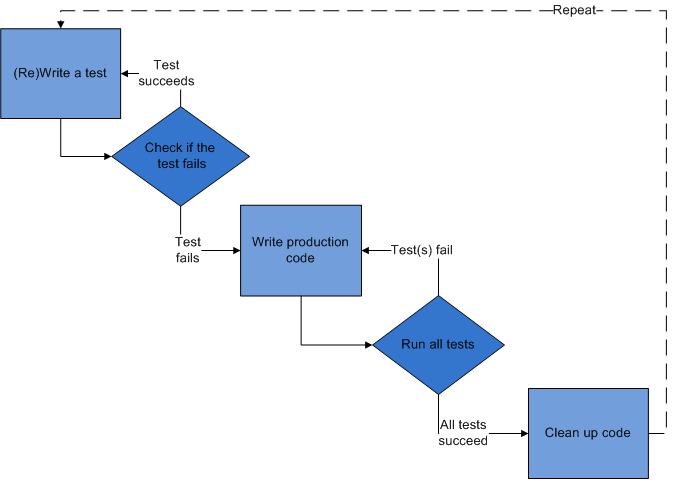CSC/ECE 517 Fall 2009/wiki2 19 as
Development methodologies
Responsibility Driven
Test Driven
Overview
Test-driven development (TDD) is a software development technique that relies on the repetition of a very short development cycle: First the developer writes a failing automated test case that defines a desired improvement or new function, then produces code to pass that test and finally refactors the new code to acceptable standards.
The following flowchart shows the typical development cycle of TDD:
Strengths
Test-driven development offers more than just simple validation of correctness, but can also drive the design of a program. By focusing on the test cases first, one must imagine how the functionality will be used by clients (in the first case, the test cases). So, the programmer is only concerned with the interface and not the implementation. This benefit is complementary to Design by Contract as it approaches code through test cases rather than through mathematical assertions or preconceptions.
The power test-driven development offers is the ability to take small steps when required. It allows a programmer to focus on the task at hand as the first goal is to make the test pass. Exceptional cases and error handling are not considered initially. Tests to create these extraneous circumstances are implemented separately. Another advantage is that test-driven development, when used properly, ensures that all written code is covered by a test. This can give the programming team, and subsequent users, a greater level of trust in the code.
While it is true that more code is required with TDD than without TDD because of the unit test code, total code implementation time is typically shorter.[9] Large numbers of tests help to limit the number of defects in the code. The early and frequent nature of the tests helps to catch defects early in the development cycle, preventing them from becoming endemic and expensive problems. Eliminating defects early in the process usually avoids lengthy and tedious debugging later in the project.
TDD can lead to more modularized, flexible, and extensible code. This effect often comes about because the methodology requires that the developers think of the software in terms of small units that can be written and tested independently and integrated together later. This leads to smaller, more focused classes, looser coupling, and cleaner interfaces. The use of the Mock Object design pattern also contributes to the overall modularization of the code because this pattern requires that the code be written so that modules can be switched easily between mock versions for unit testing or "real" version for deployment.
Because no more code is written than necessary to pass a failing test case, automated tests tend to cover every code path. For example, in order for a TDD developer to add an else branch off an existing if statement, the developer would first have to write a failing test case that motivates the branch. As a result, the automated tests resulting from TDD tend to be very thorough: they will detect any unexpected changes in the code's behaviour. This detects problems that can arise where fixing something later in the development cycle unexpectedly alters other functionality.
TDD encourages developers to put the minimum amount of functional code into modules and maximize the logic that is extracted into testable library code, using fakes and mocks to represent the outside world.
Weaknesses
Behavior Driven
Behavior Driven Development (or BDD) is an Agile software development technique that encourages collaboration between developers, QA and non-technical or business participants in a software project.
Domain Driven
Domain-driven design (DDD) is an approach to the design of software, based on the two premises:
Model Driven
Model-driven engineering (MDE) is a software development methodology which focuses on creating models, or abstractions, more close to some particular domain concepts rather than computing (or algorithmic) concepts. It is meant to increase productivity by maximizing compatibility between systems, simplifying the process of design, and promoting communication between individuals and teams working on the system.
